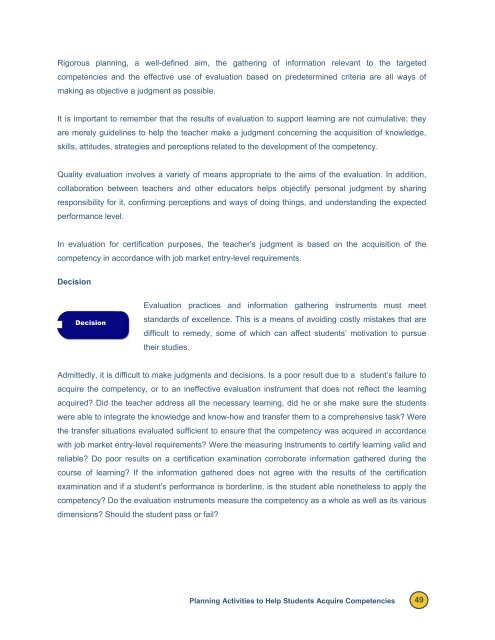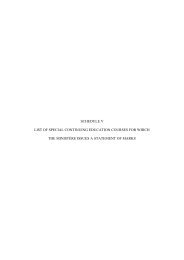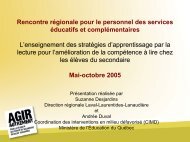Reference Framework for Planning Learning and Evaluation Activities
Reference Framework for Planning Learning and Evaluation Activities
Reference Framework for Planning Learning and Evaluation Activities
Create successful ePaper yourself
Turn your PDF publications into a flip-book with our unique Google optimized e-Paper software.
Rigorous planning, a well-defined aim, the gathering of in<strong>for</strong>mation relevant to the targeted<br />
competencies <strong>and</strong> the effective use of evaluation based on predetermined criteria are all ways of<br />
making as objective a judgment as possible.<br />
It is important to remember that the results of evaluation to support learning are not cumulative; they<br />
are merely guidelines to help the teacher make a judgment concerning the acquisition of knowledge,<br />
skills, attitudes, strategies <strong>and</strong> perceptions related to the development of the competency.<br />
Quality evaluation involves a variety of means appropriate to the aims of the evaluation. In addition,<br />
collaboration between teachers <strong>and</strong> other educators helps objectify personal judgment by sharing<br />
responsibility <strong>for</strong> it, confirming perceptions <strong>and</strong> ways of doing things, <strong>and</strong> underst<strong>and</strong>ing the expected<br />
per<strong>for</strong>mance level.<br />
In evaluation <strong>for</strong> certification purposes, the teacher’s judgment is based on the acquisition of the<br />
competency in accordance with job market entry-level requirements.<br />
Decision<br />
Decision<br />
<strong>Evaluation</strong> practices <strong>and</strong> in<strong>for</strong>mation gathering instruments must meet<br />
st<strong>and</strong>ards of excellence. This is a means of avoiding costly mistakes that are<br />
difficult to remedy, some of which can affect students’ motivation to pursue<br />
their studies.<br />
Admittedly, it is difficult to make judgments <strong>and</strong> decisions. Is a poor result due to a student’s failure to<br />
acquire the competency, or to an ineffective evaluation instrument that does not reflect the learning<br />
acquired Did the teacher address all the necessary learning, did he or she make sure the students<br />
were able to integrate the knowledge <strong>and</strong> know-how <strong>and</strong> transfer them to a comprehensive task Were<br />
the transfer situations evaluated sufficient to ensure that the competency was acquired in accordance<br />
with job market entry-level requirements Were the measuring instruments to certify learning valid <strong>and</strong><br />
reliable Do poor results on a certification examination corroborate in<strong>for</strong>mation gathered during the<br />
course of learning If the in<strong>for</strong>mation gathered does not agree with the results of the certification<br />
examination <strong>and</strong> if a student’s per<strong>for</strong>mance is borderline, is the student able nonetheless to apply the<br />
competency Do the evaluation instruments measure the competency as a whole as well as its various<br />
dimensions Should the student pass or fail<br />
<strong>Planning</strong> <strong>Activities</strong> to Help Students Acquire Competencies 49




